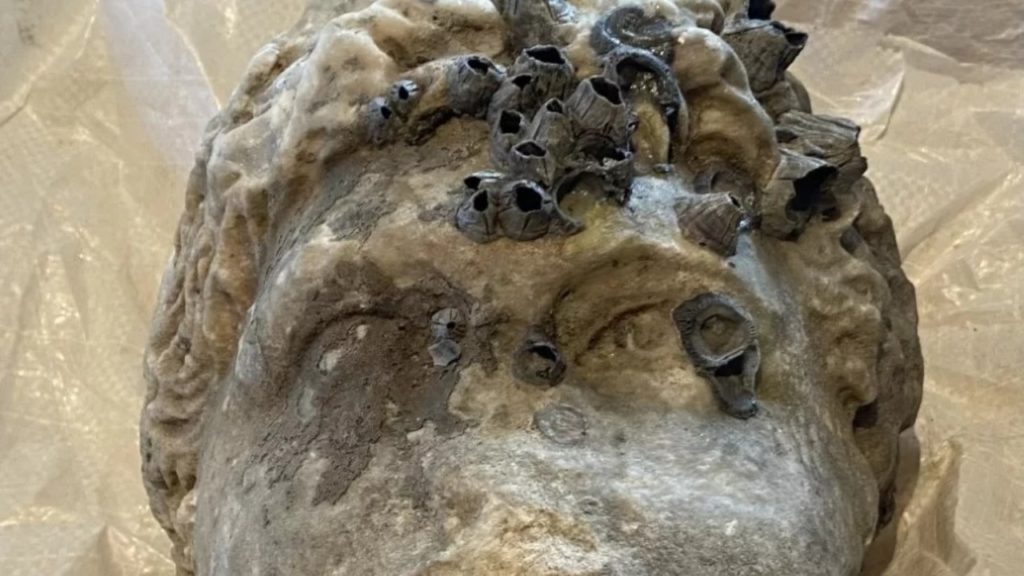
An exquisite sculpture of a head made of Pentelic marble was discovered in the sea off Preveza, in Epirus, western Greece, this week.
The Greek Ministry of the Interior announced on Tuesday that the Roman-era head of a sculpture had been pulled from the sea off Preveza after they had received a tip on its location.
With an intricate headdress that now is adorned with barnacles, the sculpture is thought to have been from the time of the Emperors Antoninus or Severus, from the second to the third century AD.
Found at a depth of about 10 meters, or thirty feet, the head is almost completely intact, with the exception of parts of the headdress, the nose, right ear and part of the chin.
Desalinization and restoration work on the bust commenced immediately thanks to experts at the Archaeological Museum of Nikopolis.
Dimitris Karamanidis informed the Port Authority of Preveza, about the possible location of the bust under the water. The port authority then organized a dive in which an archaeologist from EFA Preveza also participated.

Other archaeologists supervised the excavation and organized the transfer of the new treasure to the Archaeological Museum of Nikopolis.
Preveza is a city in the region of Epirus, northwestern Greece, located on the northern peninsula at the mouth of the Ambracian Gulf. It is the capital of the regional unit of Preveza.
In antiquity, the south-southwestern part of Epirus was inhabited by the Greek tribe of Cassopeans, part of a larger tribe, the Thesprotians. Their capital city was Cassope (today located near the village of Kamarina).
Marble head found off Preveza, Greece part of illustrious history of Epirus region
King Pyrrhus founded the town of Berenikea, or Berenike, named after his mother-in-law Berenice I of Egypt, At the southernmost part of Epirus, in 290 BC. Today, it is believed that Berenikea lies on the hills near Preveza following the excavations by Sotirios Dakaris in 1965.
The Ionian Sea off Berenikea was the site of the naval Battle of Actium, one of the greatest maritime battles of all time, on September 2, in the year 31 BC, in which Octavian’s forces defeated those of Mark Antony and Cleopatra of Egypt.
The ancient city of Nicopolis (Νικόπολις, “Victory City”) was built nearby by the Roman emperor Augustus to commemorate that victory. The city is believed to have had, at its peak, a population of 150,000.
In the year AD 90, the Greek philosopher Epictetus came to live in Nicopolis after he had been banished by the Roman emperor Domitian, and established a school of philosophy. there.
The existence of the city was first attested in the Chronicle of the Morea in 1292. After 1204, it came under the Despotate of Epirus. It then came under Venetian rule until it was captured by the Ottomans in 1463.
The Ottomans re-founded Preveza probably in 1477, with a subsequent strengthening of the fortifications in 1495. The naval Battle of Preveza was fought off the shores of Preveza on 29 September 1538, where the Ottoman fleet of Hayreddin Barbarossa defeated a united Christian fleet under the Genoese captain Andrea Doria.
Prize of the city of Preveza contested by Venetians, Ottomans
The city was hotly contested over in several Ottoman-Venetian wars. In September 1684, at the early part of the Morean War, the Venetians, aided by Greek irregulars, crossed from the island of Lefkada (Santa Maura) and captured Preveza as well as Vonitsa, which gave them control of Acarnania – an important morale booster towards the main campaign in the Morea.
However, at the end of the war in 1699 Preveza was handed back to Ottoman rule. Venice captured Preveza again in 1717, during its next war with the Ottomans and was this time able to hold on to the town and fort it – a meager achievement in a war which otherwise went very badly for the Republic.
Venetian rule would persist until the very end of the Venetian Republic itself in 1797. During this period, in 1779, the Orthodox missionary Kosmas visited Preveza, where it is said he founded a Greek school — which would be the only school of the city during the 18th century.
At the end of the 18th century, Preveza became a center of trade with western Europe (particularly France), which resulted in the increase of its population to approximately 10,000–12,000. Today it is a picturesque city boasting a modern harbor with all the amenities for yachtsmen, along with Venetian architecture, the ruins of fortifications and other buildings spanning the eras of its history.
See all the latest news from Greece and the world at Greekreporter.com. Contact our newsroom to report an update or send your story, photos and videos. Follow GR on Google News and subscribe here to our daily email!



